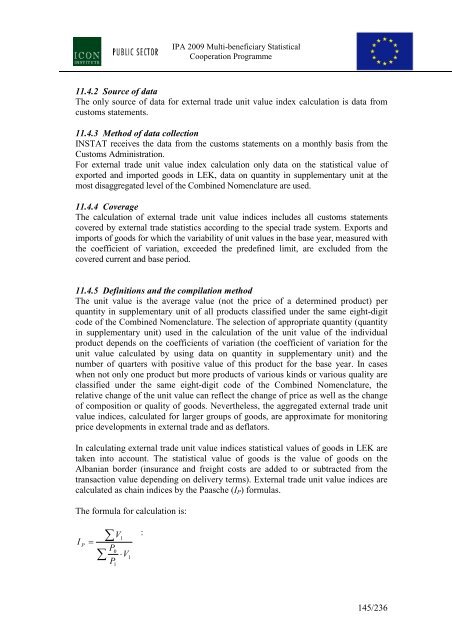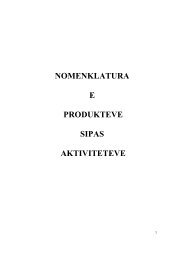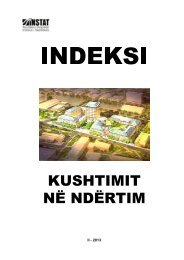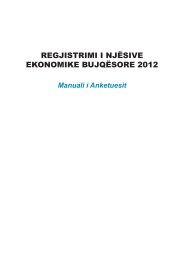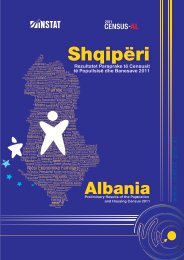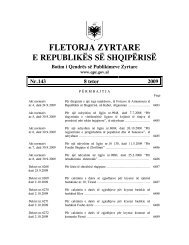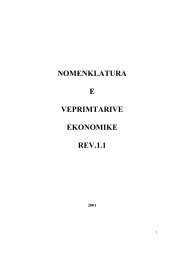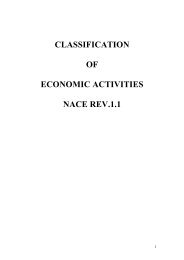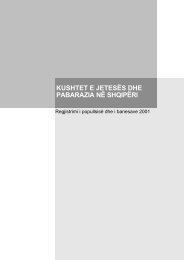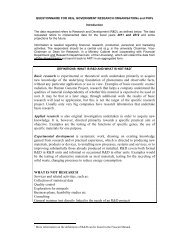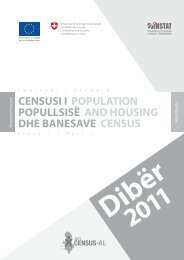Description of methods and sources for Albania - INSTAT
Description of methods and sources for Albania - INSTAT
Description of methods and sources for Albania - INSTAT
- No tags were found...
Create successful ePaper yourself
Turn your PDF publications into a flip-book with our unique Google optimized e-Paper software.
IPA 2009 Multi-beneficiary StatisticalCooperation Programme11.4.2 Source <strong>of</strong> dataThe only source <strong>of</strong> data <strong>for</strong> external trade unit value index calculation is data fromcustoms statements.11.4.3 Method <strong>of</strong> data collection<strong>INSTAT</strong> receives the data from the customs statements on a monthly basis from theCustoms Administration.For external trade unit value index calculation only data on the statistical value <strong>of</strong>exported <strong>and</strong> imported goods in LEK, data on quantity in supplementary unit at themost disaggregated level <strong>of</strong> the Combined Nomenclature are used.11.4.4 CoverageThe calculation <strong>of</strong> external trade unit value indices includes all customs statementscovered by external trade statistics according to the special trade system. Exports <strong>and</strong>imports <strong>of</strong> goods <strong>for</strong> which the variability <strong>of</strong> unit values in the base year, measured withthe coefficient <strong>of</strong> variation, exceeded the predefined limit, are excluded from thecovered current <strong>and</strong> base period.11.4.5 Definitions <strong>and</strong> the compilation methodThe unit value is the average value (not the price <strong>of</strong> a determined product) perquantity in supplementary unit <strong>of</strong> all products classified under the same eight-digitcode <strong>of</strong> the Combined Nomenclature. The selection <strong>of</strong> appropriate quantity (quantityin supplementary unit) used in the calculation <strong>of</strong> the unit value <strong>of</strong> the individualproduct depends on the coefficients <strong>of</strong> variation (the coefficient <strong>of</strong> variation <strong>for</strong> theunit value calculated by using data on quantity in supplementary unit) <strong>and</strong> thenumber <strong>of</strong> quarters with positive value <strong>of</strong> this product <strong>for</strong> the base year. In caseswhen not only one product but more products <strong>of</strong> various kinds or various quality areclassified under the same eight-digit code <strong>of</strong> the Combined Nomenclature, therelative change <strong>of</strong> the unit value can reflect the change <strong>of</strong> price as well as the change<strong>of</strong> composition or quality <strong>of</strong> goods. Nevertheless, the aggregated external trade unitvalue indices, calculated <strong>for</strong> larger groups <strong>of</strong> goods, are approximate <strong>for</strong> monitoringprice developments in external trade <strong>and</strong> as deflators.In calculating external trade unit value indices statistical values <strong>of</strong> goods in LEK aretaken into account. The statistical value <strong>of</strong> goods is the value <strong>of</strong> goods on the<strong>Albania</strong>n border (insurance <strong>and</strong> freight costs are added to or subtracted from thetransaction value depending on delivery terms). External trade unit value indices arecalculated as chain indices by the Paasche (I P ) <strong>for</strong>mulas.The <strong>for</strong>mula <strong>for</strong> calculation is:I PP1V10V1P:145/236


